Imagine your child’s eyes lighting up with excitement as they discover a newfound passion, whether it’s the intricate process of assembling a model airplane or the joyful challenge of strumming their first chord on a guitar. Introducing kids to diverse hobbies is more than just a way to pass the time; it’s the key to unlocking their potential and broadening their horizons.
This adventure not only sparks creativity but also cultivates essential life skills and self-confidence. Through the ups and downs of these activities, children learn the art of perseverance, social interaction, and the joy of learning—gifts that last a lifetime.
Creative Arts

Diving into the expansive universe of creative arts unlocks a treasure trove of imagination and skill-building opportunities for children. This realm isn’t just about producing art; it’s a conduit for expressing the inexpressible, exploring uncharted territories of the mind, and developing a rich palette of skills. The creative arts stand out for their diversity, offering a myriad of pathways for every child to find their unique voice. From the tactile joy of molding clay to the rhythmic allure of a strumming guitar, the array of options is boundless.
Here are compelling reasons to nudge your child towards the vibrant world of creative arts, alongside a curated list of activities that span the spectrum of this fascinating hobby category:
- Fosters Imagination and Self-expression: Engaging in drawing, painting, and creative writing not only propels children into vast seas of imagination but also equips them to express their emotions and thoughts in distinct, creative ways. Adding to this, pottery allows for a hands-on experience in shaping and bringing to life one’s visions, while digital art introduces them to the limitless possibilities of technology-infused creativity.
- Develops Artistic Skills and Patience: Delving into hobbies such as scrapbooking and photography helps children fine-tune their artistic eye, while knitting and origami teach them the beauty of patience and the gratification of witnessing an idea manifest into reality. Meanwhile, sculpting and jewelry making offer tactile and intricate ways to develop fine motor skills and an appreciation for detail.
- Boosts Confidence and Cognitive Skills: Learning to play musical instruments, like the piano or guitar, not only fosters perseverance but also inflates self-esteem. Participating in theater arts or film making enhances cognitive abilities through problem-solving, critical thinking, and collaboration, making them not just fun activities but also instrumental in personal development.
Incorporating these cool hobbies into your child’s life not only enriches their developmental years with fun and learning but also sets a foundation for lifelong interests. Whether it’s the classic hobby of sketching, the exciting hobbies of animation and dance, or the contemplative practice of creative writing, each activity offers a unique blend of challenges and joys. By exploring these creative avenues, children not only harness their potential but also embark on a journey of self-discovery and growth, making the creative arts a perfect hobby category to explore.
Outdoor Adventures

Venturing into the great outdoors opens up a spectrum of exciting hobbies for kids, providing them with a unique blend of adventure, learning, and health benefits. From camping to birdwatching, the array of activities available makes it easy to find something that will capture the interest and imagination of any child. These activities are more than just enjoyable pastimes; they are crucial for nurturing an appreciation for the environment, enhancing physical fitness, and supporting mental health. Here’s a list of some of the top outdoor hobbies that offer a range of benefits for kids.
| Outdoor Hobby | Benefits for Kids |
|---|---|
| Camping | Teaches survival skills, teamwork |
| Hiking | Enhances physical fitness, resilience |
| Stargazing | Boosts curiosity, scientific interest |
| Birdwatching | Fosters patience, environmental awareness |
| Gardening | Instills responsibility, life cycle education |
| Fishing | Develops patience, respect for nature |
| Kayaking | Builds strength, encourages exploration |
| Rock Climbing | Improves problem-solving, increases strength |
| Cycling | Promotes endurance, offers freedom to explore |
| Orienteering | Enhances navigation skills, decision-making |
| Nature Photography | Cultivates artistic skills, observation |
| Geocaching | Encourages problem-solving, adventure |
| Beachcombing | Teaches about marine life, environmental care |
Gardening, in particular, is a rewarding hobby that teaches kids about the importance of nurturing life, not just through the act of planting but in witnessing the unfolding of life and understanding the cycles of nature. Engaging in these outdoor hobbies provides more than mere entertainment; it lays the groundwork for developing a diverse set of skills, values, and unforgettable memories. Encouraging your kids to embrace the great outdoors through these hobbies is an excellent way to enrich their lives. So, why not inspire your children to explore the top outdoor hobbies today and discover the myriad joys and learning opportunities they present?
Mind-Expanding Puzzles
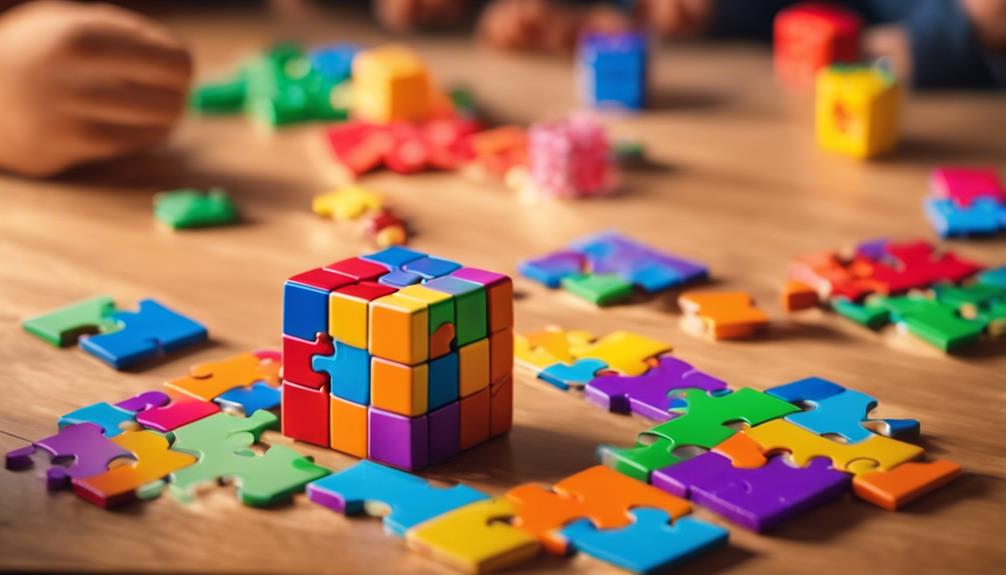
Mind-Expanding Puzzles and Brain-Boosting Activities
Engaging in mind-expanding puzzles and brain-boosting activities offers not only a world of physical and mental benefits but also plays a pivotal role in enhancing cognitive development for both children and adults. These activities aren’t merely entertaining; they serve as a rigorous exercise for the brain, propelling individuals to develop essential skills beneficial in various life aspects.
Here are three key advantages of incorporating puzzles and similar activities into your routine:
- Improves Problem-Solving Skills: Engaging in puzzles such as Sudoku, logic challenges, or escape rooms forces individuals to think critically and devise solutions, significantly honing their problem-solving capabilities.
- Boosts Cognitive Skills: Regular participation in these activities enhances memory, attention to detail, and concentration, which are fundamental for success in academic pursuits and professional life.
- Enhances Self-Esteem: Overcoming the obstacles presented by a challenging puzzle or activity provides a sense of achievement, thereby boosting confidence and self-esteem, and encouraging further exploration of new challenges.
Incorporating these activities into daily life not only keeps individuals engaged but also sharpens their minds. From improving pattern recognition to boosting analytical reasoning, these puzzles and activities offer a fun yet educational way to support developmental growth.
Here is a list of engaging and mind-expanding hobbies from this category, embodying the essence of a cool hobby while catering to a variety of interests:
- Sudoku: A classic number puzzle that improves logic and pattern recognition.
- Crosswords: Enhances vocabulary and trivia knowledge, offering a linguistic challenge.
- Rubik’s Cube: A 3D puzzle that enhances spatial awareness and problem-solving skills.
- Chess: A strategic game that improves foresight, planning, and tactical thinking.
- Jigsaw Puzzles: Boosts visual-spatial reasoning and patience.
- Brain Teasers: Challenges cognitive thought processes and enhances creative thinking.
- Logic Puzzles: Improve logical reasoning and deductive reasoning skills.
- Escape Rooms: Real-life team puzzles that enhance collaboration, problem-solving, and quick thinking.
- Trivia Games: Increase knowledge on a wide range of topics and improve memory.
- Word Searches: Improve pattern recognition and vocabulary.
- 3D Modeling Puzzles: Enhance spatial visualization and creativity.
- Strategy Board Games: Boost strategic thinking, planning, and social interaction.
- Memory Games: Enhance short-term memory and concentration.
Engaging in these activities offers a dynamic way to keep the mind sharp and entertained, making them a perfect hobby for individuals looking to enhance their cognitive abilities while having fun.
Science Experiments

Diving into science experiments, kids embark on thrilling adventures that not only enhance their problem-solving skills but also spark their curiosity about the world. This engaging activity stands out as a fun hobby that immerses them in hands-on learning while fostering critical thinking. It’s an excellent avenue for children to delve into scientific principles in a dynamic and enjoyable way, nurturing a profound respect for nature and a lasting passion for discovery. With the convenience of conducting experiments at home using readily available materials, it proves to be both accessible and cost-effective for families.
Here are three key reasons why science experiments are an outstanding hobby for kids:
- Promotes Critical Thinking: By actively participating in experiments, kids develop the ability to assess problems and devise innovative solutions.
- Encourages Curiosity: The natural inquisitiveness of children is met with practical, hands-on answers through science experiments.
- Accessible Learning: With most activities requiring just simple household items, this hobby is easily attainable for everyone.
Expanding on this fantastic hobby category, below is a list of 9 to 13 engaging and interesting hobbies related to science experiments that kids might enjoy:
- Astronomy: Exploring the stars and planets through telescopes or even the naked eye can be a fascinating introduction to the wonders of the universe.
- Robotics: Building and programming robots teach children the basics of engineering and computer science in a hands-on way.
- Chemistry Experiments: Mixing safe household chemicals to create reactions helps kids understand chemical properties and reactions.
- Biology Projects: Observing plants and animals in their natural habitats can spark an interest in life sciences.
- Physics Challenges: Simple experiments like building bridges from spaghetti or creating marble runs can demonstrate principles of physics in a fun manner.
- Geology Rocks Collection: Collecting and studying different types of rocks and minerals can be an interesting hobby for budding geologists.
- Weather Monitoring: Setting up a mini weather station allows kids to learn about meteorology by tracking temperature, wind, and rainfall.
- Eco-Friendly Projects: Engaging in projects that promote sustainability, like building a compost bin or a rainwater collection system, teaches environmental science.
- Coding and Programming: Learning to code through fun projects, like creating simple games or animations, introduces children to computer science.
- Microscopy: Using a microscope to explore the tiny world of cells and microorganisms can be an eye-opening experience.
- DIY Electronics: Simple circuit projects, like making a flashlight or a small fan, offer a practical introduction to electronics.
- Archaeology Dig Kits: Kids can simulate the experience of being an archaeologist with kits that allow them to excavate and study replicas of ancient artifacts.
- Kitchen Science: Conducting edible experiments using food items teaches basic science concepts and is a delicious way to learn.
Including these exciting hobbies on the list highlights the vast array of accessible and enjoyable activities that fall under the umbrella of science experiments. Whether it’s through observing the night sky, building a robot, or exploring the microscopic world, these hobbies offer endless opportunities for discovery, making them a perfect hobby for curious minds.
Musical Exploration

Exploring music opens up a world where kids can unleash their creativity, sharpen their minds, and embark on a journey of self-discovery and cultural enrichment. Diving into the realm of musical exploration isn’t just about hitting the right notes; it’s a gateway to developing invaluable life skills and discovering exciting hobbies that enrich their lives in various ways.
Here are three compelling reasons to encourage your child’s musical journey, alongside a list of exciting hobbies within the musical exploration category:
- Boosts Cognitive Skills and Memory: Engaging in musical activities isn’t only enjoyable but also serves as brain food. Studies have shown that kids who partake in musical hobbies have enhanced memory and cognitive skills. This benefit extends beyond the aim of becoming a music prodigy; it’s about boosting brainpower in a fun, engaging manner. Hobbies like learning to play the piano, violin, or guitar can significantly contribute to this cognitive development.
- Enhances Coordination and Confidence: Starting with an instrument can be challenging but is an excellent way to improve hand-eye coordination. Achieving milestones such as mastering a new piece or performing in front of an audience can greatly elevate a child’s self-confidence. Hobbies such as drumming, playing the flute, or even digital music production require and build upon this coordination and confidence.
- Fosters Cultural Awareness and Stress Relief: Music, being a universal language, allows children to broaden their cultural horizons and develop a deeper appreciation for diversity through the exploration of different genres. Additionally, playing and listening to music are fantastic stress relievers, offering a creative outlet for emotions. Hobbies like exploring world music, singing, and songwriting can be particularly enriching in this regard.
To further enrich your child’s musical journey, here is a list of exciting hobbies that span the spectrum of musical exploration, making it the perfect hobby category for your child to dive into:
- Learning to play a new instrument such as the ukulele or harp, which can be both a challenging hobby and a source of joy.
- Joining a choir or a musical theatre group, which combines singing with acting skills.
- DJing, allowing kids to mix tracks and understand the art of music production.
- Music composition and notation, fostering creativity in creating original pieces.
- Attending live concerts and musicals, to appreciate music in its many forms and settings.
- Exploring music history and theory, enriching their understanding of music’s evolution and its technical aspects.
- Participating in music camps or workshops, which are great for immersive learning experiences.
- Collecting musical instruments or vinyl records, for those who also appreciate the tactile and historical aspects of music.
Encouraging kids to delve into these musical hobbies isn’t just about discovering a potential talent; it’s about enriching their lives with the myriad benefits and joys music has to offer, making it an excellent choice for a fun, engaging, and culturally enriching activity.
Historical Reenactments

Imagination truly comes to life in historical reenactments, presenting a dynamic and engaging playground for children to explore and appreciate the myriad stories that have shaped our world. This isn’t merely about dressing up; it’s an immersive journey back in time, where kids have the opportunity to embody the roles of history’s most intriguing figures. From the intensity of reenacting a pivotal battle to the everyday life of a medieval villager, children gain a deep, profound appreciation for the narratives that have crafted our current reality.
Historical reenactments are far more than a simple costume affair; they represent a detailed exploration into the unique interests and intricacies of different eras. Participants, especially children, learn the critical importance of accuracy, from the garments they don to the props they utilize, ensuring every recreated scene or event authentically reflects the past.
| Skill Developed | Activity Example | Benefit |
|---|---|---|
| Teamwork | Planning a reenactment scene | Fosters collaboration |
| Creativity | Designing costumes | Enhances imaginative thinking |
| Research | Learning about historical events | Boosts knowledge and appreciation for history |
Engaging in historical reenactments encourages children to venture beyond their comfort zones, collaborate with others, and dive deep into their creative reserves. By participating in these activities, they’re not merely learning about history; they are experiencing it firsthand, making it a perfect hobby for those interested in the past.
Within this broad hobby category, there are numerous specialized interests, each offering a unique window into the past. Here is a list of some of the most interesting and popular historical reenactment hobbies:
- Civil War Reenactments: Participants recreate famous battles, camp life, and military strategies from the American Civil War era.
- Medieval Tournaments: Individuals engage in jousting, archery, and medieval combat, often within the setting of a renaissance fair.
- Revolutionary War Reenactments: Reenactors relive key moments of the American Revolution, highlighting the struggle for independence.
- Viking Village Life: This reenactment focuses on the daily life, crafts, and traditions of Viking society.
- Pirate Reenactments: Participants explore the adventurous life of pirates, focusing on naval combat and treasure hunting.
- Roman Gladiator Games: A reenactment of ancient Roman sports and combat, showcasing the skills of gladiators.
- Wild West Shows: Recreating the life and times of the American frontier, including cowboy culture, Native American history, and the Gold Rush.
- Victorian Era Balls: Reenactors dress in period attire and participate in authentic Victorian dances and social customs.
- World War II Reenactments: Focusing on the global conflict of the 20th century, participants recreate battles, resistance movements, and home front activities.
- Ancient Egyptian Life: Exploring the culture, religion, and daily activities of ancient Egypt.
- 17th Century Pirate Life: Delving into the Golden Age of Piracy, with a focus on naval engagements and the pirate lifestyle.
- Colonial American Life: Reenactors showcase the daily life, crafts, and challenges of early American settlers.
- Knights and Castles: Focusing on the feudal system, chivalry, and castle life in medieval Europe.
Pet Care Skills

Exploring pet care as a hobby not only offers kids a chance to nurture their responsibility and empathy but also introduces them to a world of diverse activities that can enrich their lives and foster a lifelong bond with animals. From the simple joy of everyday routines to the excitement of learning new skills, pet care encompasses a range of engaging hobbies that can benefit your child in numerous ways.
- Dog Walking: This activity instills the importance of regular exercise and outdoor exploration, promoting a healthy lifestyle for both the pet and the child.
- Pet Training: Teaching tricks or basic obedience not only strengthens communication between the child and their pet but also boosts the child’s confidence as they see the results of their dedicated effort.
- Aquarium Maintenance: Setting up and caring for a fish tank introduces children to the basics of aquatic life and ecosystems, fostering a sense of responsibility towards maintaining a healthy living environment.
- Bird Watching: Encouraging an interest in avian friends can start in one’s backyard, promoting patience and attentiveness as children learn to identify different species and their habits.
- Pet Photography: Capturing the beauty and unique personalities of animals through photography is a fun hobby that enhances creativity and offers a delightful way to document life with pets.
- Horseback Riding: Beyond the thrill of riding, caring for horses teaches respect for animals, discipline, and the importance of hard work and commitment.
- Volunteering at Animal Shelters: This altruistic activity allows children to contribute positively to the wellbeing of animals in need, fostering empathy and a sense of community service.
- Creating DIY Pet Toys: Engaging in crafting homemade toys for pets isn’t only a creative outlet but also a practical way to ensure pets are entertained and stimulated.
- Pet First Aid Course: Learning the basics of pet first aid is a valuable skill that emphasizes the importance of being prepared for emergencies, enhancing a child’s sense of responsibility.
- Pet Blogging or Vlogging: Sharing experiences and tips about pet care through blogging or vlogging can be an exciting hobby that hones writing or video production skills and helps connect with a community of pet lovers.
- Grooming and Styling: Learning how to properly groom pets not only keeps them healthy and comfortable but also allows children to take pride in their pet’s appearance.
- Pet Nutrition and Cooking: Preparing homemade pet treats or meals teaches kids about nutrition and the importance of a healthy diet, adding a tasty twist to pet care responsibilities.
These hobbies not only make for an interesting activities list but also equip children with a range of skills and knowledge that will serve them throughout their lives. By diving into pet care as a hobby, children discover the joy and satisfaction that come from nurturing a deep, empathetic bond with animals, making it a perfect hobby for young animal enthusiasts.
Aquatic Sports
Delving into the vibrant realm of aquatic sports opens up a myriad of opportunities for kids to engage in activities that not only elevate their physical and mental health but also add an element of exhilarating fun to their routine. From swimming to more niche pursuits like synchronized swimming, each aquatic sport offers its unique benefits and challenges, making them a perfect hobby for children looking for excitement and growth.
Here’s a detailed exploration of various aquatic sports that could become your child’s next great interest:
- Swimming: The cornerstone of aquatic sports, swimming is excellent for enhancing cardiovascular health, muscle strength, and flexibility, all while being a vital life skill.
- Diving: This sport combines athleticism and precision, as divers learn to perform acrobatic jumps and flips from various heights.
- Water Polo: A team sport that builds endurance and teamwork, water polo is essentially soccer in the water, demanding both strategic play and physical strength.
- Synchronized Swimming: A blend of swimming, dance, and gymnastics, this sport encourages creativity, coordination, and strength, making it a unique challenge.
- Surfing: Riding the waves isn’t only thrilling but also tests balance, agility, and an understanding of oceanic environments.
- Kayaking: Paddling through water, whether calm or rapids, kayaking builds upper body strength and is a great way to explore nature from a new perspective.
- Canoeing: Similar to kayaking but with a different paddling technique, canoeing offers a peaceful way to traverse water bodies and is great for all ages.
- Kite Surfing: For the more adventurous, kite surfing combines aspects of wakeboarding, windsurfing, surfing, paragliding, and gymnastics into one extreme sport.
- Stand-Up Paddleboarding (SUP): This sport has gained popularity for its simplicity and the full-body workout it provides, perfect for exploring calm waters.
- Triathlon (Swimming Segment): While not exclusively aquatic, the swimming segment of a triathlon challenges participants to master open water swimming, transitioning smoothly between sports.
- Open Water Swimming: Moving beyond the pool into lakes, rivers, and oceans, open water swimming is for those who enjoy natural settings and the added challenge of varying conditions.
- Aquathlon: Combining swimming and running, this sport is excellent for those who enjoy both aquatic and terrestrial challenges.
- Underwater Hockey: Also known as Octopush, this unique sport takes hockey to the bottom of a swimming pool, requiring players to maneuver a puck across the pool floor.
Incorporating these exciting hobbies into your child’s routine not only promises a boost in their physical and mental health but also instills invaluable life skills, promotes social and personal growth, and sparks a lifelong interest in leading an active lifestyle. Whether your child is just starting or looking to master a new aquatic activity, the world of aquatic sports offers a diverse list of opportunities to dive into, making it a perfect hobby area for kids eager to explore and excel.
Cultural Crafts
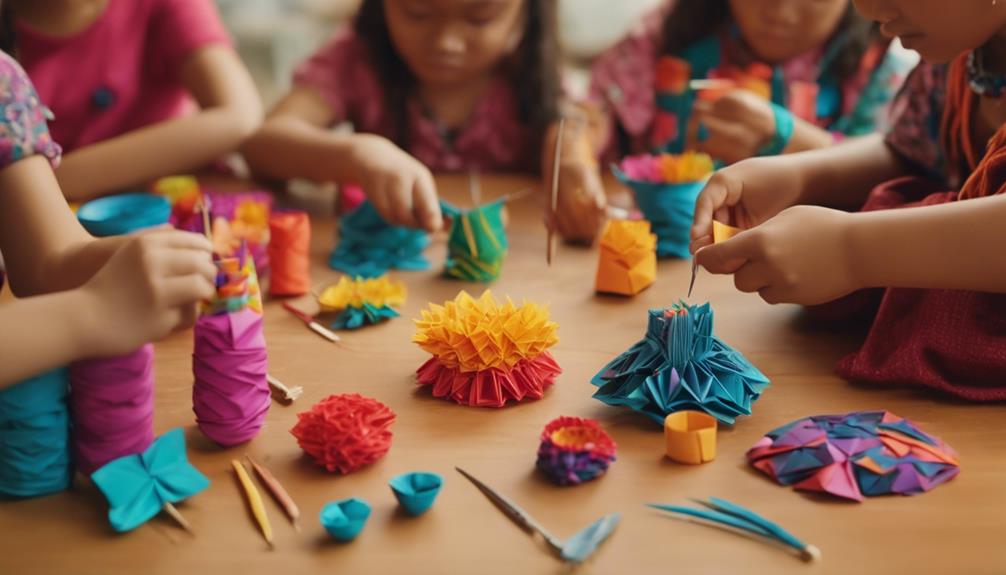
Exploring the realm of cultural crafts not only opens a gateway for children to the vast diversity of traditions and artistic expressions across the globe but also serves as a perfect hobby that’s educational, enjoyable, and immensely fulfilling. By diving into various cultural crafts, children embark on a journey that significantly boosts their creativity, enhances their fine motor skills, and deepens their appreciation for the global mosaic of cultures.
Here are reasons to introduce your child to this enriching activity, followed by a list of 9 to 13 cultural crafts that could ignite their interest:
- Understanding Diverse Cultures: Crafting items rooted in different traditions allows children to explore the customs, stories, and values of various cultures, broadening their global perspective.
- Boosting Creativity and Fine Motor Skills: The intricate nature of crafting improves dexterity and encourages the development of artistic skills, making it a great activity to enhance creativity.
- Encouraging Inclusivity and Appreciation for Diversity: Engaging with the artistic forms from around the world teaches children to value and celebrate cultural differences, promoting a more inclusive worldview.
Cultural crafts aren’t merely an avenue for creating beautiful objects; they’re a means to immerse in and understand the diversity of the world, expressing oneself artistically while fostering a profound respect for cultural variations.
Here are some cultural crafts that could be the perfect hobby for your child to start on this enriching path:
- Origami (Japan): The art of paper folding, offering both simplicity and complexity in creating figures from animals to intricate designs.
- Calligraphy (China): Practicing the elegant brush strokes of Chinese characters can be both a meditative and educational activity.
- Batik (Indonesia): A method of wax-resist dyeing on fabric, introducing children to patterns and the importance of patience and precision.
- Māori Carving (New Zealand): Wood, bone, or stone carving reflecting Māori heritage, teaching respect for materials and cultural narratives.
- Dreamcatchers (Native American): Crafting these woven nets isn’t only an artistic endeavor but also a lesson in the values and beliefs of Native American cultures.
- Pottery (Multiple Cultures): From Greek amphoras to Native American clay pots, pottery is a hands-on way to explore ancient and contemporary techniques and styles.
- African Mask Making: Delving into the symbolism and functionality of masks in various African cultures, nurturing creativity and respect for cultural meanings.
- Irish Dancing: While not a ‘craft’ in the traditional sense, learning the steps of traditional Irish dances offers insight into Celtic culture and is a great physical activity.
- Diya Painting (India): Decorating clay lamps used during Diwali teaches kids about Indian festivals and the significance of light.
- Pisanki (Poland): The intricate art of egg decorating that involves layers of wax and dye, offering lessons in patience and precision.
- Tatting (France): A technique of creating delicate lace that can be traced back to the 19th century, perfect for enhancing fine motor skills.
- Papier-mâché (France/Mexico): A versatile crafting technique used around the world but notably for Mexican piñatas and French decorative items, promoting creativity and understanding of global celebrations.
Digital Art Creation
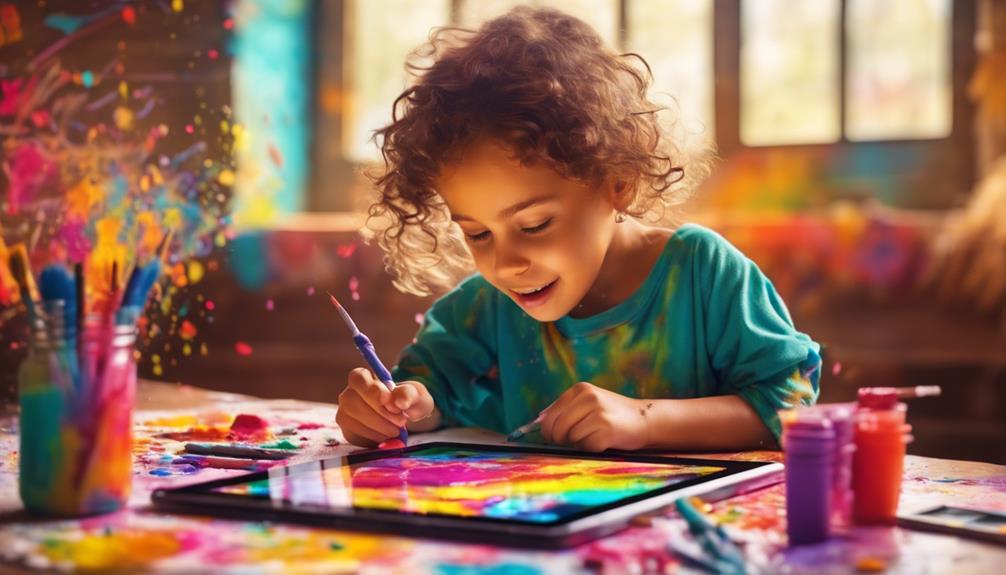
In the digital age, diving into the world of digital art creation stands out as a perfect hobby for kids, opening up a realm of creativity and innovation through modern tools such as drawing tablets and advanced software. This pastime isn’t just about self-expression; it arms them with essential digital competencies, potentially setting the stage for future careers in the diverse spectrum of digital arts.
Digital art creation transcends mere hobby status, acting as a gateway to a universe of creativity. Children can engage in a wide array of digital art activities, each fostering their imagination, technical abilities, and emotional growth in unique ways. Here’s a list of 9 to 13 hobbies within the digital art creation category that are particularly engaging:
- Digital Painting: Using software to mimic traditional painting techniques, kids can experiment with brushes, colors, and textures without the mess of actual paint.
- 3D Modeling: Creating three-dimensional digital objects and environments, perfect for those interested in video game design or animation.
- Animation: From simple GIFs to complex animated narratives, learning animation allows kids to bring their stories and characters to life.
- Pixel Art: Crafting images pixel by pixel, which is great for retro video game enthusiasts and those who appreciate the pixel art aesthetic.
- Digital Illustration: Combining art and technology to create illustrations for books, websites, and other media.
- Graphic Design: Learning layout, typography, and visual communication skills to create appealing designs and visuals.
- Character Design: Focusing on creating characters for comics, video games, and animations, helping kids delve into storytelling and character development.
- Typography and Calligraphy: Using digital tools to explore the art of beautiful lettering, perfect for aspiring designers.
- Photo Editing: Enhancing and manipulating photos to create stunning visuals or surreal artworks.
- Stop Motion Animation: Using digital software to create animation frame by frame with physical objects.
- Web Comics: Creating and publishing digital comics, an excellent outlet for storytellers and illustrators.
- Interactive Art: Designing art that allows viewer interaction, merging coding with creativity for a unique experience.
- Virtual Reality Art: Crafting immersive 3D art experiences, pushing the boundaries of traditional and digital art forms.
Each of these hobbies connects deeply with emotions such as joy, curiosity, pride, and wonder, leading to outcomes like unique creations, skill development, career pathways, and the exploration of infinite projects. Engaging in these exciting hobbies isn’t just entertaining; it’s an investment in a child’s future, nurturing a blend of creativity and technical skill that’s invaluable in today’s digital-centric world.
Robotics and Coding
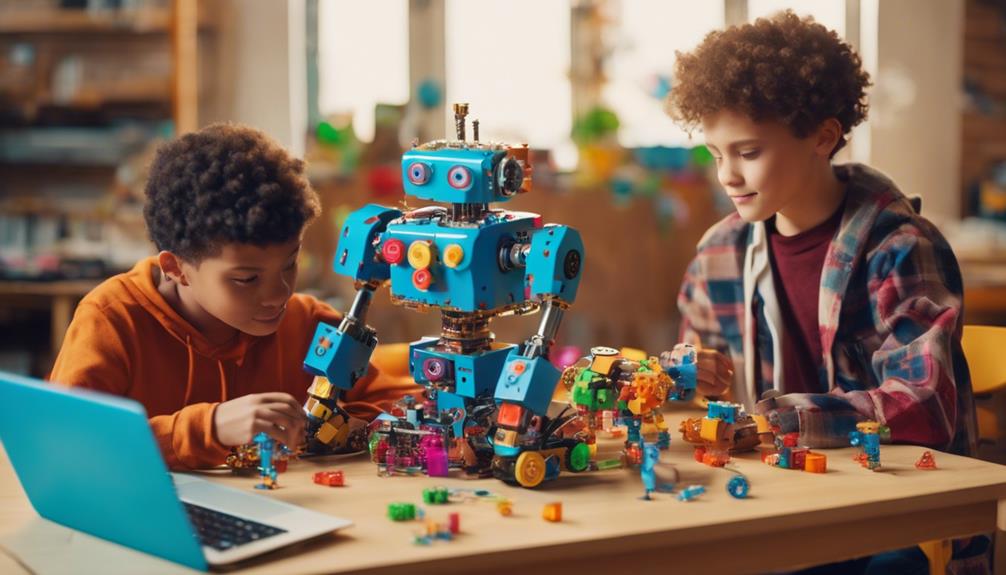
Exploring further into the realm of digital creativity, robotics and coding not only stand as thrilling activities but also elevate your child’s problem-solving and innovative thinking skills to new heights. By diving into these pursuits, your child embarks on an enlightening journey that bolsters their creativity, innovation, and technological literacy. It’s an engaging and interactive method to master complex STEM concepts, establishing a solid foundation for a future teeming with opportunities in high-demand fields. Robotics and coding aren’t merely educational tools; they encapsulate a fun hobby that prepares your child for an exhilarating, tech-driven future.
Here’s why robotics and coding aren’t only educational but incredibly fun:
- Hands-On Learning: Kids are naturally inclined to explore through touch. Building robots and writing code provide tangible results of their efforts, from a robot navigating an obstacle course to a fully functional game they programmed themselves.
- Encourages Creativity: The possibilities are endless. Each project represents a new challenge, pushing kids to innovate and devise unique solutions.
- Prepares for the Future: Our world is becoming more technologically oriented by the day. Engaging in these hobbies offers kids a competitive edge in understanding and shaping future technologies.
To further enrich this engaging hobby, here are between 9 to 13 hobbies within the realm of robotics and coding that not only are educational but serve as great fun for children:
- Drone Programming: Kids can learn to code drones to perform various tasks and maneuvers, combining the thrill of flight with the challenge of programming.
- Game Development: By creating their own video games, children learn coding, storytelling, and design.
- Website Design: Introduces the basics of HTML, CSS, and JavaScript, empowering kids to build their own websites.
- Mobile App Development: Encourages children to develop useful or fun apps, teaching them about user interface design and coding.
- LEGO Robotics: Combines the fun of LEGO with the fundamentals of robotics, a perfect hobby for hands-on learners.
- 3D Printing and Design: Kids can design their own creations and bring them to life with a 3D printer.
- Virtual Reality (VR) Projects: Introduces children to the concepts of VR and allows them to create immersive experiences.
- Artificial Intelligence (AI) Projects: Kids can explore the basics of AI and machine learning, creating simple AI-based games or tools.
- Electronics and Circuit Design: Teaches about electricity and circuits through the creation of gadgets and electronic devices.
- Stop Motion Animation: Combines creativity with technology, as kids craft stories and bring them to life frame by frame.
- Digital Music Production: Introduces the basics of music theory and digital tools, allowing kids to compose their own music.
- Cybersecurity Basics: Educates on the importance of online safety and basic cybersecurity principles.
- Arduino Projects: With Arduino, kids can create interactive electronic objects, learning about hardware and software integration.
Each of these exciting hobbies offers a unique blend of creativity, problem-solving, and technical skill, making them not just educational activities but also some of the most engaging and fun hobbies for kids who are eager to explore the world of technology.
Coding Adventures

Embark on a coding adventure where kids and adults alike learn to master the language of computers, from Scratch and Python to JavaScript, unlocking a world of creativity and problem-solving skills. Coding adventures aren’t just about typing lines of code; they’re a gateway to building digital literacy in a fun and engaging way. As learners dive into these coding journeys, they not only grasp the fundamentals of computer programming but also enhance their logical thinking and creativity.
Here are three key reasons why coding adventures are an incredible hobby for kids and adults:
- Creativity Unleashed: Individuals can create their own games, animations, and unique projects, transforming abstract ideas into tangible realities.
- Problem-Solving Skills: Every step in coding is a mini-puzzle waiting to be solved, enhancing critical thinking and persistence.
- Future Career Prep: Engaging in coding hobbies lays a solid foundation for any technology-driven career, setting individuals up for success in a digital world.
Coding adventures offer a playful yet profound way for people of all ages to interact with technology. By learning to code, they’re not just playing on the computer; they’re becoming fluent in the digital language of the future.
To dive deeper, here are between 9 to 13 coding-related hobbies that range from beginner to advanced levels, making coding an enjoyable hobby for anyone interested in technology:
- Scratch Programming: Perfect for beginners, especially kids, to understand the basics of programming through drag-and-drop blocks.
- Python Projects: Ideal for those looking to transition from beginner to intermediate, Python offers simplicity and power.
- JavaScript Games: For those interested in web development, JavaScript allows the creation of interactive web games.
- Arduino Projects: Combining coding with electronics, Arduino projects are great for hands-on learners.
- Raspberry Pi Creations: From building your own computer to creating smart home devices, Raspberry Pi offers endless possibilities.
- Mobile App Development: Using platforms like Flutter or React Native, individuals can create their own mobile applications.
- Web Development: Learning HTML, CSS, and JavaScript to build and design websites.
- Game Development: With engines like Unity or Unreal, enthusiasts can create their own video games.
- AI and Machine Learning Projects: For the advanced learner, diving into AI can open up a world of possibilities.
- Cybersecurity Challenges: Engaging in ethical hacking and security challenges to safeguard digital assets.
- Blockchain Development: Exploring the creation of cryptocurrencies and smart contracts.
- Data Science Projects: Analyzing data sets to find patterns, predictions, and insights.
- 3D Modeling and Printing: Combining coding with design to create physical objects from digital models.
These exciting hobbies not only equip individuals with future-ready skills but also provide endless hours of entertainment and challenge. Coding, indeed, is a classic hobby that continues to evolve with technology, making it one of the most interesting and valuable activities to pursue.
Tabletop Role-Playing
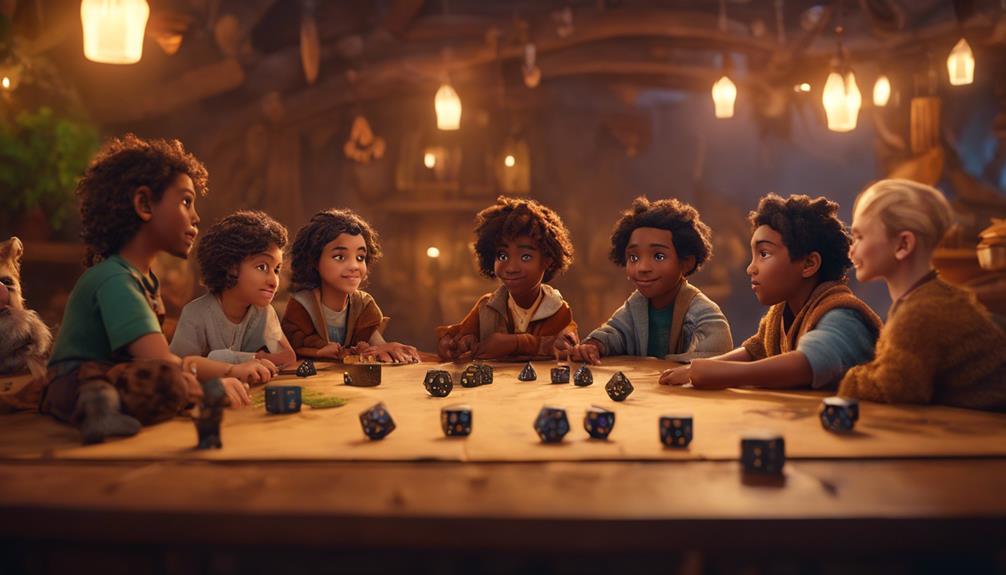
After mastering the digital realm with coding adventures, it’s time to transition to the communal and imaginative world of tabletop role-playing games (TTRPGs). These games aren’t merely a source of entertainment; they serve as gateways to fantastical worlds where creativity, teamwork, and problem-solving skills aren’t only encouraged but required. Imagine your child setting off on grand quests, unraveling complex mysteries, and overcoming daunting challenges—all from the comfort of your dining room table.
Here are three reasons why tabletop role-playing games have become such a popular activity:
- Unleash Creativity: Players are thrust into a universe of endless possibilities, taking on the roles of wizards, astronauts, or mythological beings. It’s an exercise in dynamic storytelling and imagination.
- Build Teamwork and Social Skills: Working together with friends or family to tackle challenges fosters important lessons in cooperation and communication.
- Enhance Critical Thinking: Each decision shapes the course of the story, offering a safe and engaging way for players to understand the repercussions of their choices and to develop strategies for success.
Tabletop role-playing games like Dungeons & Dragons are more than just games—they are experiences that nurture creativity, teamwork, and critical thinking, all while providing an educational, immersive, and incredibly enjoyable adventure. Ready to explore your child’s next favorite hobby? Here’s a list of some of the most interesting TTRPGs that promise to captivate and challenge players of all ages:
- Dungeons & Dragons: The classic fantasy role-playing game that has set the standard for TTRPGs, offering a rich world of adventure and imagination.
- Pathfinder: Similar to D&D but with its own unique rule set and world, appealing to those looking for a slightly different flavor of fantasy.
- Call of Cthulhu: Dive into a world of cosmic horror inspired by the works of H.P. Lovecraft, where investigation and sanity play key roles.
- Star Wars Roleplaying Game: Explore the galaxy far, far away by embodying characters from the iconic Star Wars universe.
- Shadowrun: A cyberpunk-meets-fantasy game where magic, technology, and intrigue collide in a dystopian future.
- Gloomhaven: A hybrid between a board game and a TTRPG, offering a persistent and evolving world with a strong narrative and tactical combat.
- Vampire: The Masquerade: Enter the dark world of vampires, weaving tales of politics, horror, and intrigue.
- Fiasco: A game focused on small-time capers gone disastrously wrong, perfect for those who love storytelling and improvisation.
- Warhammer Fantasy Roleplay: A grim world of perilous adventure where players face off against the dark forces that threaten the Old World.
- Cyberpunk 2077: Based on the popular video game, this TTRPG takes players into a dystopian future filled with cybernetics, intrigue, and high-octane action.
- Monster of the Week: Inspired by shows like Buffy the Vampire Slayer, players take on the roles of monster hunters in this action-packed game.
- Tales from the Loop: Explore a version of the ’80s that never was, filled with mysterious technology and strange creatures.
Whether your child is drawn to the fantastical, the futuristic, or the downright spooky, there’s a tabletop role-playing game that’s a perfect fit for their interests. Get ready to roll the dice on an adventure that promises to be not just a game, but a journey into the heart of imagination and camaraderie.
Benefits of hobbies for kids

Diving into hobbies offers kids a playground for their imagination, where they can develop new skills and interests in a fun and engaging way. The benefits of encouraging your child to explore popular hobbies are vast, ranging from fostering creativity to improving physical health.
- Skill Development and Creativity: Hobbies push kids to learn and master new skills, promoting a sense of achievement. Whether it’s painting, playing an instrument, or coding, each activity sharpens their minds and unleashes creativity.
- Boosts Self-Confidence and Social Skills: Engaging in hobbies gives children a platform to shine, enhancing their self-esteem. Popular group hobbies like team sports or dance classes also offer fantastic opportunities to make new friends, teaching teamwork and improving social skills.
- Promotes Physical and Mental Well-being: Active hobbies encourage kids to get up and move, contributing to their physical health. Simultaneously, mentally stimulating hobbies like chess or reading bolster cognitive development and offer a healthy outlet for stress.
Tips and tricks for hobbies for kids

Now that we’ve explored the benefits of hobbies for kids, let’s look at some practical tips and tricks to help your child find and enjoy their perfect pastime. Discovering a hobby that captures your child’s interest can be an exciting journey, and with a little guidance, they can embark on a path filled with fun, learning, and growth.
Here are three key strategies to keep in mind:
- Follow Their Curiosity: Pay close attention to what naturally intrigues your child. Whether it’s dinosaurs, space, cooking, or painting, starting with their existing interests is the best way to ensure engagement and excitement.
- Encourage Diverse Experiences: Don’t shy away from introducing your child to a wide range of activities. Experimentation is key in discovering new passions. Some hobbies might click instantly, while others may require a bit more patience and practice.
- Be an Active Participant: Show genuine interest in your child’s hobbies. Your support and participation can boost their confidence and deepen your bond. Whether it’s kicking a soccer ball around, painting together, or simply asking about their progress, your involvement is invaluable.
Be smart: Multitask and take hobbies for kids to next level
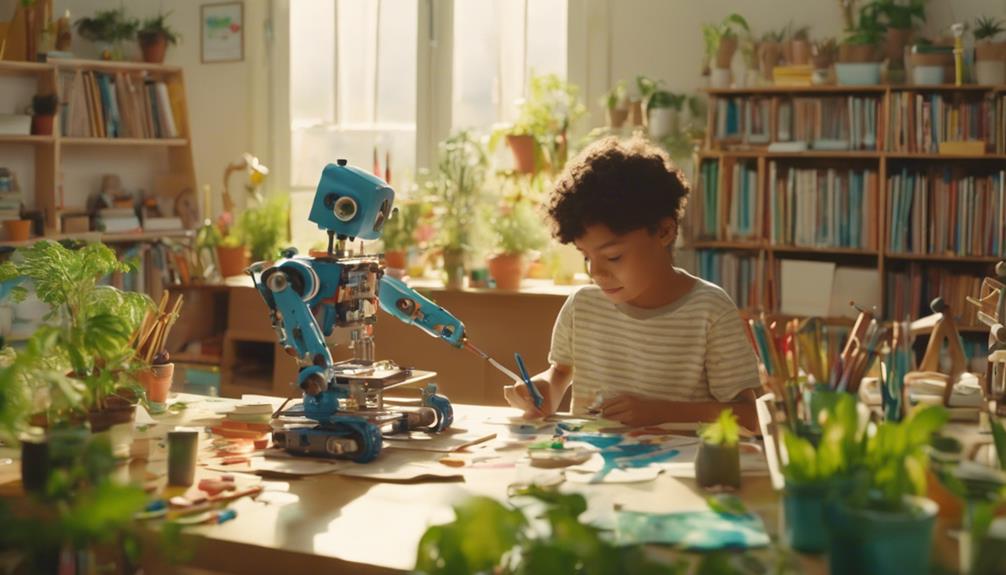
To make the most out of your child’s hobby, consider these strategies for leveraging technology and online resources:
- Incorporate Audiobooks: While your child engages in their hobby, suggest they listen to audiobooks related to their interest. Platforms like Audible.com or Blinkist.com offer a vast array of content that can enrich their knowledge and inspire new ideas without having to pause their activity. For instance, if they’re into painting, they could listen to audiobooks about famous artists or the history of art.
- Utilize Online Courses: Encourage your child to take online courses to advance in their hobby. Websites such as Coursera.org or Udemy.com provide affordable courses ranging from beginner to advanced levels. Whether they’re interested in digital art, coding, or even cooking, there’s likely a course that can help them improve their skills and knowledge from the comfort of home.
AI Crafts Suggestion Tool
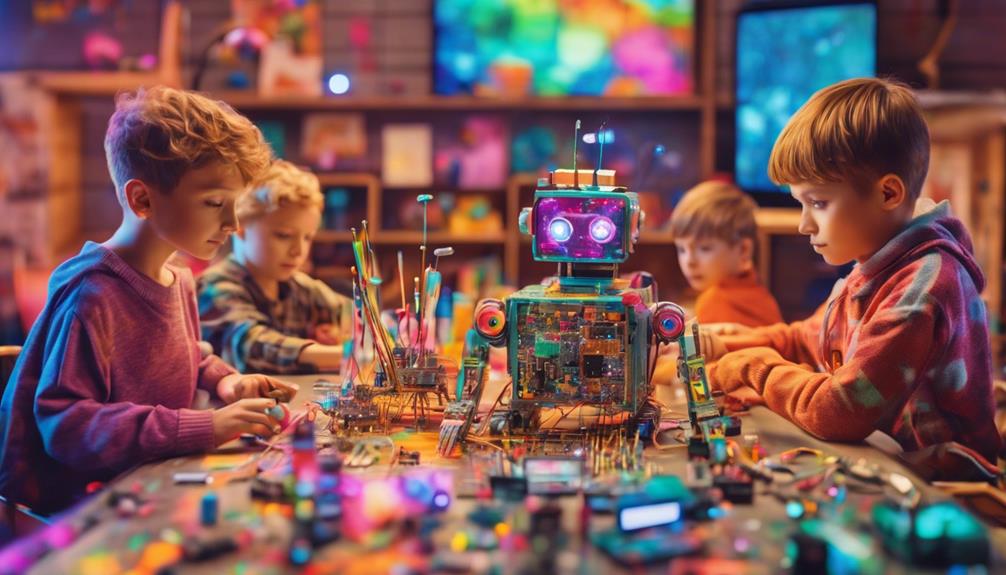
Introducing the ultimate personalization in hobby discovery: the Fully Personalized Hobby Generator. Powered by advanced AI technology, this solution offers an ultra-personalized approach to recommending hobbies that perfectly align with your unique needs and preferences. Through a friendly chatbot interaction, we dive into a series of simple questions designed to understand exactly what you’re looking for in a hobby. Whether it’s your interests, the amount of time you have available, or the specific skills you wish to develop, the more information you share with us, the more tailored our recommendations become.
Here’s how our Fully Personalized Hobby Generator revolutionizes the way you find new pastimes:
- Ultra-Personalized Recommendations: Our AI sifts through your responses to pinpoint hobbies that not only match your interests but also fit seamlessly into your lifestyle. This level of customization ensures that the hobbies suggested are those you’re genuinely likely to enjoy and pursue.
- Effortless Exploration: Say goodbye to the overwhelming task of searching for new hobbies. Our generator makes it easy to explore options you may never have thought of, all of which are curated just for you, keeping your exploration exciting and straightforward.
- Time-Saving: By directly connecting you with hobbies that cater to your specific needs and preferences, we drastically cut down the time you spend looking for the right fit. This means you can spend more time enjoying your new hobby instead of searching for it.
Dive into a world of hobbies tailor-made just for you with our Fully Personalized Hobby Generator, where discovering your next passion is just a chat away.
Final thoughts

Diving into the world of hobbies opens up a treasure chest of opportunities for your child’s development and joy. Finding the perfect hobby isn’t just about filling free time; it’s about enriching your child’s life. Engaging in various activities can significantly boost their creativity, hone skills, and build invaluable self-confidence. Remember, every child is unique, and so are their interests. The journey to discovering the perfect hobby for your child might involve exploration and experimentation, but it’s a rewarding process.
Parents play a crucial role in this adventure. Your involvement can’t only strengthen your bond but also contribute significantly to their overall well-being. Encouraging your child to try different hobbies helps in nurturing creativity and promoting essential cognitive and social skills. Plus, choosing age-appropriate activities ensures they’re getting the most out of these experiences, whether it’s through physical activity, teamwork, or personal growth.
In the end, the aim is to provide a platform for exploration that taps into your child’s interests and developmental needs. Here’s to finding that perfect hobby that sparks joy, fosters growth, and brings endless opportunities for discovery and fun!
Frequently Asked Questions
What Are Some Hobbies for 10 Year Olds?
Consider painting, drawing, or crafting to spark their creativity. Learning an instrument or joining a choir can boost their confidence. Sports, coding, and outdoor activities also offer great options.
How Do I Find a Hobby for My Child?
To find a hobby for your child, consider their interests and try different activities. Look for hobbies that boost creativity, social skills, and physical activity. Be open to exploring until you find the perfect fit.
What Do Kids Love the Most?
Kids often love activities that capture their imagination and allow for creativity. You’ll find them gravitating towards interactive hobbies like music, sports, and arts, which offer both fun and a sense of accomplishment. Kids are different, so you should communicate with them and help them discover activities and interests they might like.




